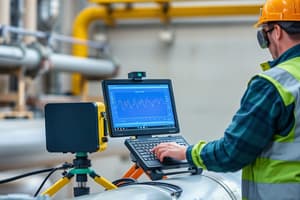Podcast
Questions and Answers
Which factors must be clearly indicated for the ILI system?
Which factors must be clearly indicated for the ILI system?
- Components, tools, and operational protocols
- Anomalies, components, and characteristics (correct)
- Components, characteristics, and inspection frequency
- Anomalies, components, and analysis methods
What must be reported as specified in Appendix 5, Tables A5-2 to A5-8?
What must be reported as specified in Appendix 5, Tables A5-2 to A5-8?
- Cost estimation for inspection services
- General guidelines for the ILI tools
- Operational constraints of the pipeline
- Detection and sizing measurement specifications (correct)
What should the performance specification include regarding higher performance analysis?
What should the performance specification include regarding higher performance analysis?
- Agreement on additional analysis with the client (correct)
- Summary of inspection technologies available
- A comparison with industry standards
- Detailed user manuals for the ILI tools
When combining different technologies (e.g., MFL, UT, EC, EMAT) into one tool, what is required?
When combining different technologies (e.g., MFL, UT, EC, EMAT) into one tool, what is required?
What is a Local Buckle primarily associated with in pipeline terminology?
What is a Local Buckle primarily associated with in pipeline terminology?
What must occur for a Propagating Buckle to happen?
What must occur for a Propagating Buckle to happen?
What are the two types of essential variables considered for ILI tool performance?
What are the two types of essential variables considered for ILI tool performance?
Which feature is described as a larger diameter pipe placed around a pipeline for protection?
Which feature is described as a larger diameter pipe placed around a pipeline for protection?
What describes the term 'Certainty' in pipeline inspections?
What describes the term 'Certainty' in pipeline inspections?
How is a 'Cluster' defined in the context of pipelines?
How is a 'Cluster' defined in the context of pipelines?
What is an example of a characteristic descriptor of a pipeline?
What is an example of a characteristic descriptor of a pipeline?
What does the term 'Colony' refer to in pipeline terminology?
What does the term 'Colony' refer to in pipeline terminology?
Who is referred to as the 'Client' in the context of pipeline operations?
Who is referred to as the 'Client' in the context of pipeline operations?
What should the operations report primarily inform the Client about?
What should the operations report primarily inform the Client about?
When should the operations report be sent to the Client?
When should the operations report be sent to the Client?
Which of the following must be included in the operations report?
Which of the following must be included in the operations report?
What data quality issue may prompt a re-run of the inspection?
What data quality issue may prompt a re-run of the inspection?
Which of the following details about the ILI run is NOT included in the operations report?
Which of the following details about the ILI run is NOT included in the operations report?
What does AGM statistics refer to in the context of the operations report?
What does AGM statistics refer to in the context of the operations report?
What condition of the tools should be reported after the ILI run?
What condition of the tools should be reported after the ILI run?
Which of the following is important to ensure before demobilization of the tool?
Which of the following is important to ensure before demobilization of the tool?
What is implied to be important for the success of the first run of an ILI tool?
What is implied to be important for the success of the first run of an ILI tool?
Which statement correctly describes the Probability Of Detection (POD) in relation to ILI tools?
Which statement correctly describes the Probability Of Detection (POD) in relation to ILI tools?
What does the tool performance specification typically link to?
What does the tool performance specification typically link to?
What type of information may the Client request before confirming an ILI contract?
What type of information may the Client request before confirming an ILI contract?
Which grades describe the technology readiness of tool class hardware?
Which grades describe the technology readiness of tool class hardware?
What is essential for the Probability of Identification (POI) regarding ILI tools?
What is essential for the Probability of Identification (POI) regarding ILI tools?
What should be communicated to the Client regarding design changes to tool components?
What should be communicated to the Client regarding design changes to tool components?
What value is recommended to specify for the probability of detection?
What value is recommended to specify for the probability of detection?
What is the primary purpose of the specifications and requirements for in-line inspection of pipelines?
What is the primary purpose of the specifications and requirements for in-line inspection of pipelines?
Which of the following features is considered an anomaly during pipeline inspections?
Which of the following features is considered an anomaly during pipeline inspections?
In the context of pipeline inspections, what does the acronym ATEX stand for?
In the context of pipeline inspections, what does the acronym ATEX stand for?
What section of the specifications discusses the criteria for determining the severity of an anomaly?
What section of the specifications discusses the criteria for determining the severity of an anomaly?
What is a 'buckle' in the context of pipeline anomalies?
What is a 'buckle' in the context of pipeline anomalies?
Which report is typically generated after completing in-line inspection of pipelines?
Which report is typically generated after completing in-line inspection of pipelines?
Which aspect is NOT covered under health and safety according to the document?
Which aspect is NOT covered under health and safety according to the document?
What is indicated by the acronym ILI in the document?
What is indicated by the acronym ILI in the document?
Which of the following parameters is related to the interaction of pipeline anomalies?
Which of the following parameters is related to the interaction of pipeline anomalies?
What is the significance of a 'tool performance specification' in pipeline inspections?
What is the significance of a 'tool performance specification' in pipeline inspections?
Which of the following is NOT a type of anomaly mentioned in the document?
Which of the following is NOT a type of anomaly mentioned in the document?
What is the purpose of the personnel qualification section in the specifications?
What is the purpose of the personnel qualification section in the specifications?
Which option refers to the action of comparing multiple in-line inspection results?
Which option refers to the action of comparing multiple in-line inspection results?
What is typically included in the final report of a pipeline inspection?
What is typically included in the final report of a pipeline inspection?
Which section addresses changes to tool specification or performance specification sheets?
Which section addresses changes to tool specification or performance specification sheets?
Flashcards are hidden until you start studying
Study Notes
Introduction
- This document specifies the advised operational and reporting requirements for tools used for geometric measurement, mapping, metal loss, crack or other anomaly detection during their passage through pipelines.
Definitions and Abbreviations
- This document defines the terms related to in-line inspection of pipelines.
- Definitions include terms like Anomaly, Buckle, Casing, Certainty, Client, Cluster, Colony, Crack, Dent, Gouge, ILI, Local Buckle, Metal Loss, Ovality, Pipeline, Probability Of Detection, Probability of Identification, Ripple/Wrinkle, Roof Topping/peaking.
- Several abbreviations are defined for common technical terms and organizations.
- Definitions are grouped into the following categories: General, Definitions, Abbreviations, Parameters and interaction, Anomaly Assessment, and Resolution of measurement parameters.
Parameters and Interaction of Anomalies
- Detailed descriptions are given for typical pipeline anomalies.
- These include Metal Loss, Dent, Gouge, Ovality, Buckle, Ripple/Wrinkle, Roof Topping/peaking, Crack and crack-like, and Crack colonies.
- The document describes the interaction of different anomalies types, emphasizing the importance of considering the combined effect of multiple anomalies within a single area.
Anomaly Assessment
- This section focuses on the assessment of detected anomalies including interaction rules and severity indication.
- It details how to assess the severity of individual anomalies, or clusters of anomalies, based on the extent of damage and potential impact on pipeline integrity.
Health and Safety
- This section discusses the health and safety standards that need to be adhered to during in-line inspections.
- The standards include ATEX and IECEx for ensuring safe operation of equipment in potentially explosive atmospheres.
Tool Specifications
- The document outlines the requirements for the ILI tool specifications.
- These include general tool data sheets, the tool class history, and tool performance specifications.
Tool Performance Specification
- Tool performance specifications define the ability of the ILI system to detect, locate, identify, and size pipeline features, components and anomalies.
- The specifications are typically linked to the inspection technology applied (e.g. UT, MFL, EC, EMAT or mapping).
- The document requires the performance specification to comply with requirements given in API 1163, chapter 6.
Tool Performance Verification
- The document details the process and requirements for verifying and validating the performance of ILI tools.
- These include the probability of detection (POD), probability of identification (POI), and measurement specifications for different types of anomalies.
- The document explains the difference between POD90/50 and POD90/95 and emphasizes the importance of clearly stating which POD value is being used.
Personnel Qualification
- The document highlights the importance of qualified personnel for conducting in-line inspections.
- The document refers to the POF document "Guidance on achieving ILI First Run Success" for further information on personnel qualifications.
ILI Preparation and Contracting
- The key elements of ILI preparation and contracting are described including preparation and contracting procedures.
Reporting
- This section outlines the reporting requirements for in-line inspections.
- It details the structure, content, and timing of different reports, including the operations report, preliminary report, final report, raw data report, multiple run comparisons report, experience report, and additional reporting.
Operations Report
- The operations report should summarize important operational information to inform the client about the success of the inspection and quality of data collected.
- The report follows good practices regarding ILI activities as described in the POF document "Guidance on achieving ILI First Run Success".
- The operations report should be sent electronically to the client before tool demobilization, and ultimately within 2 days of the ILI run unless agreed otherwise.
- It should include information like any reported safety observations, description of the operations and used tools, AGM statistics, cleaning results, gauging/dummy tool run results, details of ILI run including time and date of tool launching and receiving, travelling time, min/max tool velocity and plot over the length of the pipeline, min/max pressure, for MFL tools: min/max magnetization level, and a plot of the magnetic field strength in kA/m over the length of the pipeline measured at the inner surface of the pipe, condition of tool(s) after receipt, data loss statistics from faulty sensors, data recording and quality within contract specifications, and the suitability of the recorded data to allow a successful evaluation.
Preliminary Report
- The preliminary report provides the client with an initial assessment of the inspection results, including a summary of anomalies identified and key findings.
Final Report
- The final report should provide a comprehensive analysis of the inspection results.
- It contains various sections like pipe tally, list of anomalies, list of clusters, data loss and other lists, list of components, summary and statistical data, performance, dig sheet, software and signal, anomaly ranking method for ERF, detection of markers, and personnel qualification.
Raw Data Report
- The raw data report provides the client with the unprocessed data collected during the inspection.
Multiple Run Comparisons Report
- The multiple run comparisons report analyzes and compares data from multiple runs of the ILI tool to identify any changes in pipeline condition or the effectiveness of repair work.
Experience Report
- The experience report documents the lessons learned and insights gained from the in-line inspection process.
Additional Reporting
- The document provides the option for additional reporting based on the specific requirements of the client and the nature of the inspection.
References
- This section lists relevant references and standards referenced in the document.
- These include references to API standards, other relevant industry documents, and technical publications.
Appendix 1
- This section lists the ILI companies that provided comments to the draft version of these specifications.
Appendix 2
- This section provides a guideline to clients for defining specific details of the POF specifications.
Appendix 3
- This section explains the structure, terminology, and acronyms used in the report.
Appendix 4
- This section details the requirements for tool data sheets, providing a comprehensive guide to the information that should be included.
Appendix 5
- This section outlines the tool technology performance specifications for different inspection technologies.
Appendix 6
- This appendix provides a typical example of a pipe tally for a pipeline inspection.
Appendix 7
- This appendix provides a typical example of a list of anomalies found during a pipeline inspection.
Appendix 8
- This appendix provides a typical example of a list of clusters of anomalies identified in a pipeline inspection.
Appendix 9
- This appendix provides a typical example of a run comparison overview for multiple in-line inspections of the same pipeline.
Studying That Suits You
Use AI to generate personalized quizzes and flashcards to suit your learning preferences.




